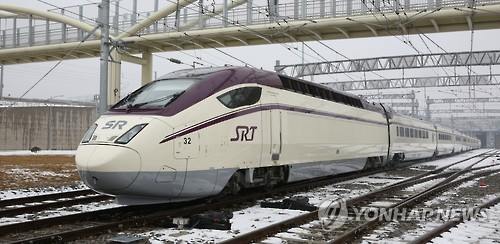
The SRT bullet train that will start operation from Seoul Suseo KTX station in August 2016. (Image : Yonhap)
SEOUL/SEJONG, Feb. 3 (Korea Bizwire) – South Korea is planning to build a national railway system by 2025 that can link Seoul with most cities in two hours, the government said Wednesday.
The third national railroad development plan aims to upgrade existing rail lines so they can accommodate high-speed trains and open new railroads that can handle semi-high speed rolling stock, the Ministry of Land, Infrastructure and Transport said.
The semi-high speed lines can be used by trains with top speeds of up to 250 kilometers per hour, compared to more than 300 km/h for local bullet trains.
The ministry claimed that the entire project could cost 74.1 trillion won (US$61.1 billion), with 53.7 trillion won coming from the central government and the rest being financed by regional administration and the private sector.
The 2016-2025 plans, which will be finalized in the first half, could connect most midsize regional cities, such as Gangneung, Sokcho and Andong, along the country’s east coast within a couple of hours of the capital city. Gangneung and Sokcho in Gangwon Province is more than 200 kilometers east of Seoul while Andong is 268 km southeast of South Korea’s largest urban center.
At present, it takes over five hours to reach Gangneung from Seoul by train and way over three hours to get to Andong.
In addition, the goal is to connect most cities within the country by a high-speed rail line so it would only be a short two-hour trip between them.
The ministry said if all goes according to plan, 85 percent of the country’s population can benefit from a high speed train service in the next decade, up from 51 percent at present.
Besides this, the government’s plan calls for extending the Korea Train Express line from Gwangju to Mokpo, the country’s southwestern region, and opening new bullet train services from Suwon, Incheon and Uijeongbu, near Seoul. It, moreover, envisions the building of the Great Train eXpress connecting downtown Seoul with satellite cities such as Ilsan and turning Korea Train Express’s Suseo station into a new hub for rail travel.’
(Yonhap)






